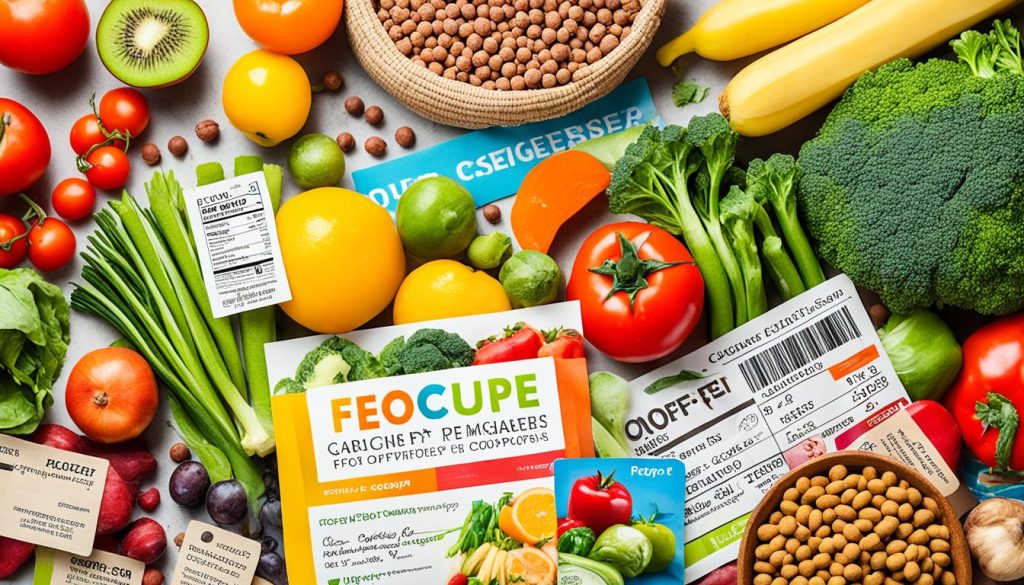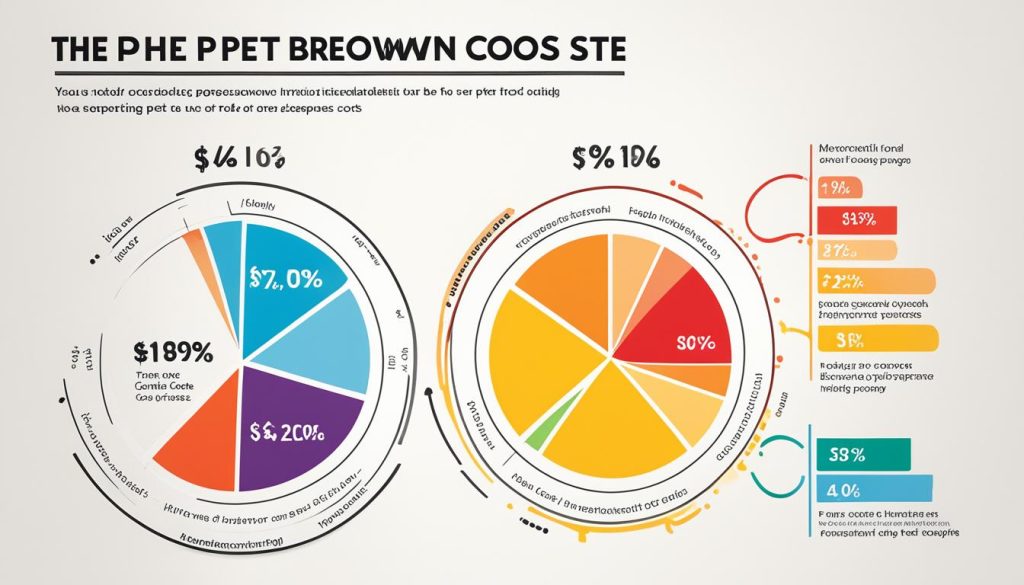As a pet owner, one of the questions you may often ask yourself is, “How much does pet food cost?” It’s important to budget wisely for your furry friend’s nutritional needs. The cost of pet food can vary depending on several factors such as the type of pet, size, and dietary needs. However, with a little research and comparison, you can find the right balance between quality and affordability.
According to various sources, the average annual expense for dog food ranges from $250 to $700, while cat food averages around $254 per year. These figures provide a general idea, but it’s crucial to understand that the cost can vary significantly based on factors like breed, age, and health condition. To get a more accurate estimate, it’s advisable to explore different options and compare prices.
When comparing pet food prices, it’s essential to consider the nutritional value. Some pet foods may seem more expensive at first glance but offer better quality ingredients and specific benefits for your pet’s health. Evaluating the cost against the value and focusing on your pet’s well-being is key to making an informed decision.
How Much Does Pet Food Cost
- Consider various factors such as breed, age, and health condition when estimating pet food costs.
- Explore different pet food options and compare prices to ensure you find the right balance between quality and affordability.
- Take into account the nutritional value of pet food to prioritize your pet’s well-being over cost.
- Consult with a veterinarian to determine the specific dietary needs of your pet.
- Keep in mind that pet food prices can vary by location, so consider the cost of living in your area when budgeting for pet food expenses.
Tips for Saving Money on Pet Food
As a pet owner, finding affordable pet food options that provide the necessary nutrition for your furry friend is essential. Here are some budget-friendly strategies to save money on pet food:
1. Make Your Own Pet Food at Home
One cost-effective option is to create homemade pet food using affordable ingredients. Vegetables, rice, and inexpensive cuts of meat can be combined to make nutritious meals for your pet. By making your own pet food, you have control over the quality of ingredients while saving money in the long run.
2. Take Advantage of Discounts and Coupons
Another way to reduce pet food expenses is by shopping smart. Look out for discounts, coupons, and special offers at pet stores or online retailers. Additionally, consider signing up for cash-back reward apps that provide savings on pet food purchases. These small savings can add up over time.
3. Consider Budget-Friendly Pet Food Brands
There are plenty of affordable pet food brands that offer good value for money without compromising on nutrition. Take the time to research and compare different options to find the best value pet food for your budget. Look for brands that meet your pet’s dietary needs while being cost-effective.
By implementing these cost-saving measures, you can provide your pet with the nourishment they need while keeping your pet food expenses in check.

Factors Affecting Pet Food Costs
When it comes to pet food costs, several factors can influence the overall expenses. It’s important for pet owners to understand these factors to make informed decisions about their pet’s nutrition while managing their budget effectively.
The type of pet you have plays a significant role in determining the cost of pet food. For example, the dietary needs and portion sizes of a large breed dog will be different from those of a small breed dog or a cat. It’s essential to consider your pet’s size and specific dietary requirements when calculating pet food expenses.
The quality of ingredients in pet food is another factor that affects cost. Higher quality pet food brands tend to be more expensive due to the use of premium ingredients and better nutritional profiles. While these brands may come with a higher price tag, they often provide added benefits and contribute to your pet’s overall health and well-being.

Special dietary requirements can also impact pet food costs. If your pet has specific dietary needs due to allergies, sensitivities, or health conditions, you may need to invest in specialized or prescription pet food, which can be more expensive than regular options. It’s important to consult with your veterinarian to ensure that your pet’s dietary needs are being met without compromising their health.
When considering pet food choices, it’s helpful to analyze the pricing of different brands. Some pet food brands offer a budget-friendly range without compromising on quality or nutritional value. Researching and comparing prices can help you find cost-effective pet food options that fit within your budget.
Calculating pet food expenses involves considering factors such as the type of pet, size, specific dietary needs, ingredient quality, and special requirements. By carefully evaluating these factors and exploring different pricing options, pet owners can make informed decisions that provide their furry friends with the nutrition they need while being mindful of their budget.
Average Pet Food Expenses by State
The cost of pet food can vary by location, and it’s important for pet owners to consider this factor when budgeting for their furry friends. According to a study, Washington state has the highest average lifetime cost for dog ownership, totaling $97,752. On the other hand, Oklahoma is the least expensive state, with an average lifetime cost of $61,581. These costs include various factors such as pet food, vet bills, and other associated expenses.
When comparing pet food prices, it’s crucial to keep in mind the cost of living in your area. While some states may have higher pet food expenses, they may also have higher wages or lower costs in other areas. Therefore, it’s essential to look at the overall budget and financial situation when analyzing pet food costs.
By understanding the average pet food expenses in different states, pet owners can make more informed decisions about their budget and choose the best budget-friendly pet food options without compromising on quality. It’s also important to consider the pet’s specific dietary needs and consult with a veterinarian to ensure they are receiving a balanced diet.
Cost-Saving Measures for Pet Food
In addition to exploring budget-friendly pet food options, there are several cost-saving measures that pet owners can take to reduce their pet food expenses.
Making pet food in bulk using affordable ingredients, such as chicken, vegetables, and rice, can help lower costs. By preparing larger quantities of homemade pet food at once, you can save both time and money. Plus, you’ll have the peace of mind knowing exactly what ingredients are going into your pet’s meals.
Another way to save on pet food is by buying in bulk. Purchasing larger quantities of pet food can often result in significant savings, especially when paired with discounts or sales at pet stores. Consider stocking up on your pet’s favorite food when you find a good deal.
Additionally, it’s worth exploring alternative sources of protein for your pet. Incorporating ingredients like eggs or fish into their diet can be a more economical option while still providing essential nutrients.
Pet owners have various ways to save money on pet food expenses. Making pet food in bulk, buying in bulk, and incorporating alternative protein sources are all effective strategies. By being mindful of cost and value, pet owners can provide their furry friends with nutritious meals without breaking the bank.
Conclusion
The cost of pet food is a significant expense for pet owners, and it’s crucial to find the right balance between quality and affordability. By understanding the factors that influence pet food costs and exploring different options, you can make informed decisions to ensure your pet receives a well-balanced diet without breaking the bank.
When considering the cost of pet food, it’s important to take into account the specific needs of your pet, such as its breed, size, and dietary requirements. Consulting with a veterinarian can provide valuable insights and guidance to help you make the best choices for your furry friend.
While comparing pet food prices, always prioritize the nutritional value of the food over the price tag. Premium pet food options may have a higher cost, but they often contain higher-quality ingredients that benefit your pet’s overall health and well-being. By investing in high-quality pet food, you can potentially prevent future health issues and reduce veterinary expenses.
It’s also essential to develop a budget and stick to it. Calculate the monthly cost of pet food and factor it into your overall budget. Consider cost-saving measures such as buying pet food in bulk or taking advantage of discounts and promotions. By planning ahead and finding cost-effective solutions, you can provide your pet with nutritious meals while managing your pet food expenses.






